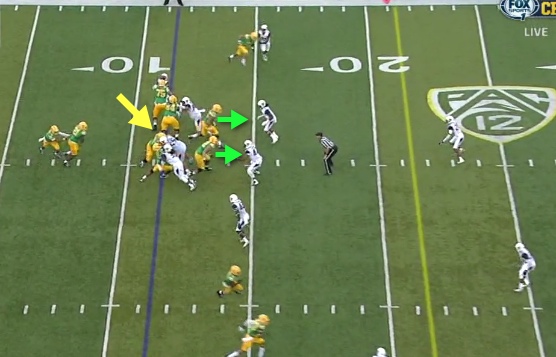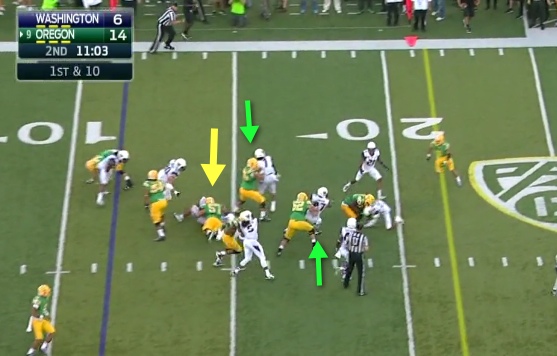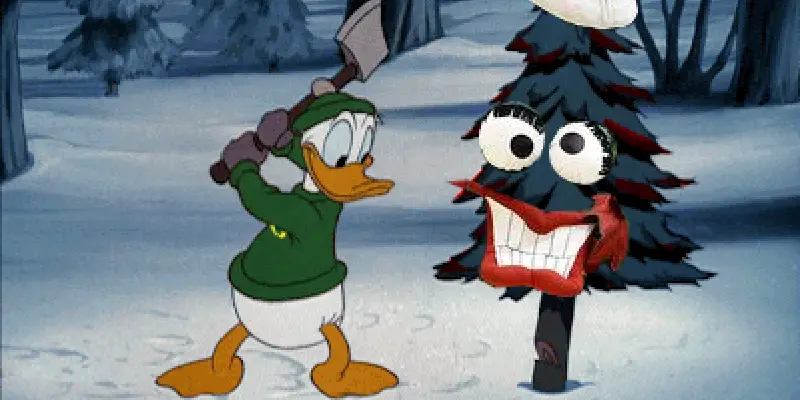Injuries do create tactical opportunities, as opponents have feasted upon Oregon’s depleted offensive tackle position earlier in the season. However, the Cardinal now have injuries that open up some unique situations that fit within our offense’s abilities to exploit and can be added on to the analysis about Stanford by FishDuck.com analyst Rory Davidson. What plays do we run to capitalize? Let’s take a look …
Focus on the Free Safety
Stanford free safety Zach Hoflpair is a talented player who has speed and superb instincts, but is ruled out of the game due to injury. He will be replaced by true freshman Terrance Alexander, and we all know how a free safety has a ton to keep track of when defending Oregon.

Stanford must stop the run … unless Oregon is passing!
Note (above) how the free safety for Stanford is moving to his left to begin help in run support against the usual Outside Zone Read of Oregon. The yellow arrows show the direction of the Cardinal defensive back and the Oregon running back. We see the green arrow of DJ Davis sprinting across the middle, and since the free safety has already begun his body mass going one direction — it is nearly impossible to reverse field and stay up with the Oregon WR.
Darron Thomas pulls the ball out of the belly of the RB (above) on the mesh, and stands up and throws a dart to Davis, who cruises into the end zone – Touchdown, Ducks! The score was a result of the run fake, or play-action movement, designed to do precisely what occurred; freeze the free safety or getting him moving the wrong direction for a split-second as an Oregon wideout bolts past him. I believe Offensive Coordinator Scott Frost will pick his spots, but will use the play-action to open up plays against the newbie Cardinal safety.
Attack the Replacement Nose Tackle

Wonderful Inside Zone blocking!
We see above a typical Inside Zone play by Oregon with Royce Freeman receiving the handoff in the middle of the field with the opportunity to select any gap. He finds one right in front of him as Doug Brenner (yellow arrow) and Hamani Stevens (No.54) have the nose tackle and one defensive end under control. We see Hroniss Grasu and Matt Pierson (green arrows) releasing and moving out to block the linebackers — and an instant like this in a running play is always a delight to study.

Royce Freeman “banging” for nine yards.
Remember how the Oregon running back is supposed to “bang” (go up the middle) “bend” (cut back to the left) or “bounce” (pop outside to the right). Here we have a tremendous example above of Freeman “banging” it. Brenner (yellow arrow) is laying on Danny Shelton of Washington, while Stevens and Pierson (green arrows) achieved their objective as Royce whooshed by the defenders for nine yards with all his momentum.
The original starter at nose tackle for Stanford is out for the game, and the backup is quite talented (David Parry) but he too is questionable for this game. The third-teamer is a true freshman at only 255 pounds? Look for Oregon to be banging the Inside Zone all day long if the rookie starts, and the play-action described in the first tactic, above, will work wonderfully when the Ducks get big chunks of real estate from their Inside Zone play.
Watch for Play Packages
The injuries to Stanford’s defensive line have hurt them in the short run, but in all probability they will field an excellent starting group. The challenge comes from many rumors which indicate that the Cardinal could have a nearly all-freshman second unit poised for action on the defensive line.
This means that Stanford will keep their starters in much longer than usual, and will be much more prone to exhaustion against Oregon’s No-Huddle offense as the game reaches its final stages. The best way to score easily from Stanford’s fatigue comes from Oregon’s running play packages, where a group of plays are called in advance and the Ducks sprint to the line of scrimmage after each play and quickly run the next play in the “package.”
I can predict what comes next … sucking air and a mistake-prone Cardinal defense.
I wish there were never injuries to any team and be able to play straight up every game to see who is truly the best, as that is the honorable approach. However, reality requires an attack on the weaknesses of the opponent — just as they have done to us in the past.
That said, look for these tactics to help the Ducks chop down the Stanford tree!

Charles Fischer (FishDuck)
Oregon Football Analyst for the CFF Network/FishDuck.com
Eugene, Oregon
Thanks to Glenn Hanna for the creation of the GIF
Related Articles:
Chip Kelly Update: Everything's Good Again ...
Chip Kelly Update: Wailing and Gnashing of Teeth
Shock and Awe -- The Oregon Ducks' Football Hangover Effect
Despite Lopsided Score, Georgia State "Never Stopped Believing"
Hope Springs Eternal for Ducks
Incompetent Pac-12 Officials: How Do You Miss ALL of THIS?

Charles Fischer has been an intense fan of the Ducks, a season ticket holder at Autzen Stadium for 38 years and has written reports on football boards for over 26 years. Known as “FishDuck” on those boards, he is acknowledged for providing intense detail in his scrimmage reports, and in his Xs and Os play analyses. He is single, has a daughter Christine, and resides in Eugene Oregon where he was a Financial Advisor for 36 years.
He now focuses full-time on Charitable Planned Giving Workshops for churches and non-profit organizations in addition to managing his two Oregon Football Websites, of FishDuck.com and the Our Beloved Ducks forum. He is a busy man!
He does not profess to be a coach or analyst, but simply a “hack” that enjoys sharing what he has learned and invites others to correct or add to this body of Oregon Football! See More…

